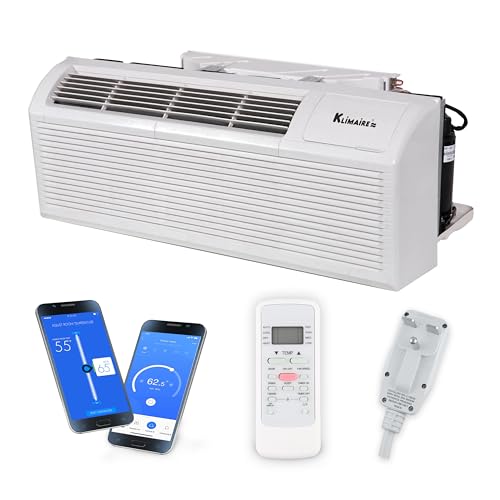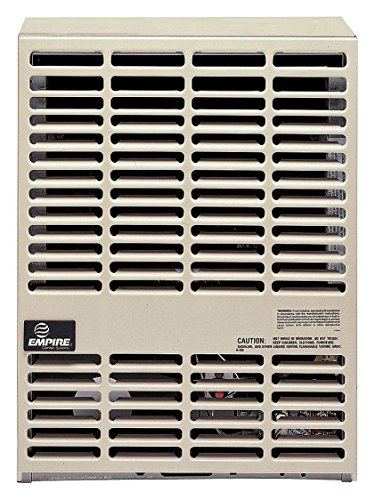Choosing the right 15,000 BTU heater depends on application — wall/PTAC installers, RV owners, or outdoor users need different types of units. The table below summarizes five well-matched products across those categories so you can compare purpose, fuel type, and installation style at a glance.
| Product | Type | Fuel / Power | Typical Use |
|---|---|---|---|
| Cooper & Hunter PTAC With Sleeve & Grille | PTAC Heat Pump + Electric | 230/208V electric, R‑32 | Hotels, apartments, residential |
| Klimaire 15,000 BTU PTAC With 5 kW Backup | PTAC Heat Pump + Electric | 208-230V electric, R‑32 | PTAC replacements, commercial/residential |
| TOSOT GO Cool RV Rooftop 15,000 BTU | Rooftop RV AC With Heat Pump | Electric, WiFi control | RVs, campers (non-ducted) |
| Mr. Heater 15,000 BTU Single Tank Top Propane | Portable Propane Radiant Heater | Propane (20 lb tank) | Worksites, garages, tents, outdoor |
| Empire DV215 NG 15,000 BTU Direct Vent | Direct Vent Wall Furnace | Natural Gas | Permanent room heating, basements |
Content Navigation
Cooper & Hunter PTAC With Sleeve And Grille

This packaged terminal air conditioner (PTAC) combines a heat pump and a 3.5 kW electric heater, packaged with a wall sleeve and exterior grille for simplified installation. It is sized to standard PTAC dimensions (42″ x 21″ x 16″) and intended for 230/208V, single-phase power. The unit uses R‑32 refrigerant and includes a 20A plug with reset breaker; you should verify outlet compatibility before purchase.
Applications include hotels, apartments, offices, and residences where a slide-in PTAC is appropriate. Because sleeve and grille are included, this listing reduces the need to source additional installation parts. Cooling capacity listed at approximately 14,700/14,500 BTU/h with heat pump heating capacity near 13,500/13,200 BTU/h plus the electric heater for auxiliary heat.
Klimaire 15,000 BTU PTAC With 5kW Backup

The Klimaire PTAC is designed as a seamless replacement for standard 42″ x 16″ slide-in sleeves and emphasizes compatibility with common PTAC installations. It uses R‑32 refrigerant and lists an EER around 10.6 for efficiency reference. The heat pump portion provides heating near 13,500/13,200 BTU/h, while the integrated auxiliary electric heater offers up to 5.0 kW of backup heat.
Call 888-896-7031 for Free Local HVAC Quotes – Compare and Save Today!
The package includes a drain kit and a wireless remote. Power requirements specify 208–230V single-phase with a 30A 3-prong grounding plug. This option is targeted at property managers and homeowners replacing aging PTAC units or upgrading to a higher auxiliary heating capacity.
TOSOT GO Cool RV Rooftop 15,000 BTU

The TOSOT GoCool rooftop unit is a non-ducted RV air conditioner with an integrated heat pump. It states a 15,000 BTU cooling capacity and approximately 12,000 BTU heating capacity, representing an option for larger RV interiors. The unit is promoted for use in RVs roughly 16 to 24 feet in length and supports outdoor temperature operability across a wide range.
Notable features include WiFi control via a mobile app and a remote for programmed operation. The unit aims for flexible performance in varying outdoor climates and is designed for rooftop installation where non-ducted airflow suits camper layouts.
Mr. Heater 15,000 BTU Single Tank Top Propane

This single-burner radiant propane heater mounts directly to a 20 lb cylinder and provides three regulator settings with a maximum output around 15,000 BTU. It is a portable radiant device intended for quick localized heating in garages, workshops, campsites, or outdoor job sites where utility power is not available.
Call 888-896-7031 for Free Local HVAC Quotes – Compare and Save Today!
Safety features listed include a tip-over shutoff. Its simple mounting and mechanical control make it a common choice when mid-range portable heat and mobility are priorities. Because it’s propane-powered, users should consider ventilation, fuel availability, and outdoor use guidelines.
Empire DV215 NG Direct Vent Wall Furnace

The Empire DV215 NG is a direct vent natural gas wall furnace rated at 15,000 BTU for space heating. It is a permanently installed unit with included venting components and is sized for room-level heating in areas such as basements, additions, or rooms lacking central heat. The product listing specifies dimensions and that vent cap hardware is included.
Direct vent designs draw combustion air from outside and exhaust directly outdoors, which enhances indoor air quality relative to non-vented gas heaters. Installation typically requires gas hookup and proper wall penetration for venting; professional installation is recommended for compliance and safety.
Buying Guide: How To Choose A 15,000 BTU Heater
Selecting a 15,000 BTU heater requires matching heat source, installation method, and safety to your needs. Below are the most important considerations to compare options objectively.
1. Intended Application
- Indoor Permanent Rooms: PTAC units or direct vent furnaces suit apartments, hotel rooms, or dedicated spaces where wall or sleeve installation is feasible.
- RVs and Campers: Rooftop non-ducted units with heat pump capability and compatibility with camper roof openings are appropriate.
- Portable/Outdoor Use: Propane radiant heaters provide mobility and quick warmth for outdoor projects, but require ventilation and fuel management.
2. Fuel And Power Source
- Electric Heat Pumps / Electric Heaters: Require compatible voltages (e.g., 208–230V) and potentially dedicated circuits; good for indoor applications with available electrical infrastructure.
- Natural Gas Direct Vent: Best for continuous indoor heating where gas service is available and venting can be installed.
- Propane Portable: Offers mobility but requires refueling and attention to safe ventilation and carbon monoxide risk.
3. Installation Requirements
- PTAC Units: Confirm sleeve size, wall opening, and whether a sleeve/grille are included. Some units are slide-in replacements while others require additional parts.
- Rooftop RV Units: Check roof curb size, weight capacity, and electrical hookup needs. Professional rooftop installation is common.
- Direct Vent Furnaces: Require wall penetration and vent termination per local codes; plan for gas line routing.
4. Heating Performance And Capacity
- BTU Ratings: 15,000 BTU indicates output potential, but effective heating depends on insulation, room volume, and climate. Use room size estimates and consider heat loss.
- Supplemental Heat: PTAC and rooftop heat pumps often include electric backup; review auxiliary kW ratings if winters are severe.
5. Efficiency And Refrigerant
- Heat Pump EER / Efficiency: Higher EER values suggest better cooling efficiency; for heating performance, check COP or manufacturer heating specs.
- Refrigerant Type: Many modern units use R‑32 for improved efficiency and reduced global warming potential compared to older refrigerants.
6. Controls And Connectivity
- WiFi And Remote: Units with WiFi or remote control enable scheduling and remote management; useful for RV owners and managed properties.
- Thermostat Compatibility: For furnaces and PTACs, check control interface and compatibility with existing thermostats or building systems.
7. Safety Features And Certifications
- Propane Heaters: Look for tip-over shutdown, flame failure protection, and CSA or equivalent safety listings.
- Gas Furnaces: Confirm direct vent design, pilot ignition type, and compliance with local building codes.
8. Maintenance And Serviceability
- Filter Access: Consider ease of filter removal and cleaning for longevity and indoor air quality.
- Replacement Parts: For PTACs, check local service networks and availability of sleeves/screws/grilles if future replacement is needed.
9. Noise And Comfort
- Noise Levels: Rooftop RV units and PTACs vary in operational noise; review manufacturer sound ratings if noise sensitivity is a factor.
- Air Distribution: Non-ducted units deliver direct airflow; furnace convection differs from forced-air distribution — choose based on comfort preference.
10. Regulatory And Venting Considerations
- Local Codes: Gas appliance installations and vent penetrations must meet local code and typically require permitted installation.
- Vent Location: For direct vent furnaces, plan appropriate exterior termination points away from air intakes and property features.
When comparing models, create a shortlist based on intended use, required fuel or electric service, and installation feasibility. Verify technical specs such as BTU cooling vs heating, auxiliary kW ratings, and required electrical circuit.
Tips for Getting the Best HVAC Prices
- Prioritize Quality Over Cost
The most critical factor in any HVAC project is the quality of the installation. Don’t compromise on contractor expertise just to save money. - Check for Rebates
Always research current rebates and incentives — they can significantly reduce your overall cost. - Compare Multiple Quotes
Request at least three estimates before making your choice. You can click here to get three free quotes from local professionals. These quotes include available rebates and tax credits and automatically exclude unqualified contractors. - Negotiate Smartly
Once you've chosen a contractor, use the proven strategies from our guide — How Homeowners Can Negotiate with HVAC Dealers — to get the best possible final price.
